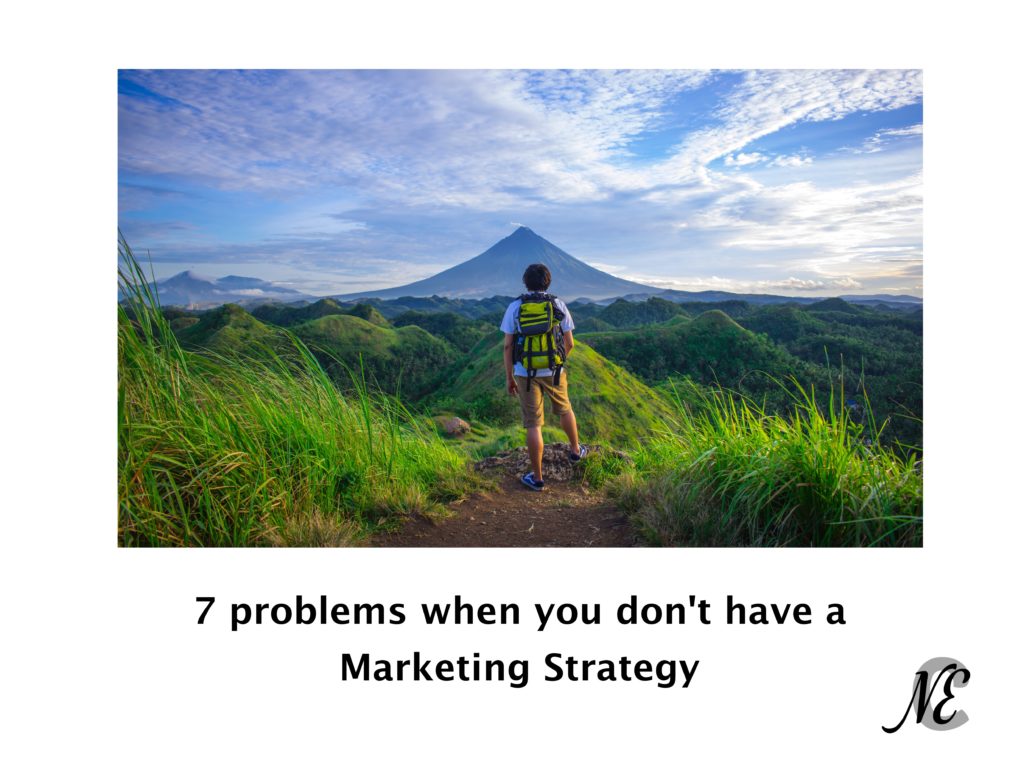7 Problems when you don’t have a marketing plan
7 Problems when you don’t have a marketing plan

According to research by Forbes, the top three (out of five) reasons that new businesses fail are marketing related. These are:
Reason #1: Not really in touch with customers through deep dialogue.
Reason #2: No real differentiation in the market (read: lack of unique value propositions)
Reason #3: Failure to communicate value propositions in clear, concise and compelling fashion.
Or to put it another way, many businesses don’t communicate compellingly because they don’t have a clear idea of what value their products need to give their customers. This, in turn, is because they don’t have a deep understanding of their customer needs.
This article looks at the elements of a good marketing plan and identifies some of the problems that will occur without one.
What is a marketing plan?
Over the years as a marketing professional working several different businesses, I have been struck by the fact that many don’t have a structured written marketing plan. It worth clarifying what I mean by “marketing plan”.
“Marketing planning is a systematic process involving the assessment of marketing opportunities and resources, the determination of marketing objectives and the development of a plan for implementation and control.” Philip Kotler.
Depending on the size and how a business works, marketing plans will vary in their complexity and level of detail. In essence, a marketing plan should include
Situation Analysis
This is the longest and most difficult part of the plan. This is because it should contain an analysis of:
Customers – Who are they? Why do they buy from you? How do they buy?
Competitors – Who are they? How do they compete with you? What are their strengths and weaknesses?
Partners and intermediaries – How do they work with you? What is the financial impact on your business? Risks of competition or loss.
Competencies – Strategic approach, management buy-in, resources, data and measurement, customer analysis, integrated communications.
Performance / Results – Summarise your business KPIs for current and at least the previous period)
Market Trends – Look at opportunities and threats to the business.
Objectives
Begin with your Mission: Why is your business is in existence? How does it make the world a better place?
Your vision This looks at where the organisation sees itself in 3, 5 or 10 years’.
One approach to setting objectives is the 5S approach. The aim is to ensure that marketing objectives are sufficiently broad-based and focus on your customers needs not simply the businesses immediate financial aims.
Sell – sales targets (the hard metrics for sales revenue and profitability
Serve- sets customer service targets
Save – identify efficiencies that can save time and money both for the customer and the organisation.
Speak – Identify ways to create customer engagement and bring customer voice into the organisation.
Sizzle – look for innovation to add new value to customers.
Strategy
Your strategy is the big picture of how you are going to deliver your objectives. This need to be broken down into the following elements listed below. Not all elements will be needed in every strategy.
Target markets: this is essential. You will need to provide a detailed account of each of the customer segments that your business has chosen to target.
Objectives – it is often useful to sense check that your strategy will meet your objectives.
Positioning – this essential and is how you want your customers to perceive you.
Partnerships – how to introduce, strengthen or manage strategic partnerships.
Customer Experience – this is at the heart of your business, so you need to define the type of customer experience that your business wants its customers to experience. There are broadly three types:
- Customer intimacy: provides a very personalised service focused on customer care.
- Platform: the service offering is around efficiency and productivity.
- Innovation: you are committed to providing your customers with cutting-edge products and services.
Customer Journey – Understanding the customer journey is essential to planning an effective communications plan. There are several ways to analyse the customer journey. A modern way of viewing the customer journey uses the See, Think, Do, Care model created by Avinashi Kaushik. This model aims to look at our communications from a customer-centric approach.
See: this is your largest qualified addressable audience.
Think: the segment of the “See” audience that is thinking about a particular problem/solution/issue.
Do: that part of the “Think” segment that are also willing to buy your product/solution/service.
Care: is about caring for your “best” customers. For example, those that have purchased multiple products or those that have renewed your service.
Most businesses focus their communication on the “Do” segment. See, Think, Do encourages the business to consider how they can actively move their audience towards purchase. The Care element ensures that you continue to understand and communicate with your valued customers.
Tactics
While the strategy looks at the bigger picture of what needs to be done, the Tactics look at these in more detail. Inclusions in the tactics section include:
The 7Ps extended marketing mix comprises the following elements (Tutor2u provides a brief description of each):
Product: the good or service that the customer buys.
Price: how much the customer pays for the product.
Place: how the product is distributed to the customer.
Promotion: how the customer is found and persuaded to by.
People: the people who make contact with customers in delivering the product.
Process: the systems and processes that deliver a product to a customer.
Physical evidence: the material element e.g. brochures and policy documents that represent an intangible service.
Communications mix
Identify the online and offline tools communicate with your audience in every stage of the journey. Plan these into your communications calendar.
But is a marketing plan necessary? The fact is most businesses will have an idea of what projects/activities they want to do now and at some point, in the future.
But is this enough? Why bother to go to the trouble of preparing a marketing plan?
Actions
The action section is about delivery. This requires the management of staff, resources and processes to create a compelling proposition that is communicated with energy.
The Action section will involve creating many individual action plans or projects. It will include:
– Content planning
– Marketing Automation
– Use of database and CRM.
– Constant review and improvement.
Control
The control section measures the success of the planned activities. These should be measured in as much detail as possible. You will need to create a hierarchy with top-level KPIs to be reported to senior management to provide an overview of the success of sales and marketing activities. Such KPIs could include, sales volume, revenue, return on investment, market share and position.
Each area of your operation should then have its own sets of KPIs that feed into the top-level KPIs. For example, you will need to have a set of website-related KPIs, which include sources of visitors, number of visitors, length of visit, number of pages viewed etc.
It is also important to have a broad range of other metrics that you may need to call upon to enable you to analyse the reasons for the success or failure of particular elements of the plan.
No marketing plan? Expect problems
There are some of the reasons why creating a structured plan would make your business more effective.
- Avoids a reactive approach to business opportunities
I have worked for business where the senior management would veer from one project to another based which was the most recent opportunity that was presented to them.
Projects are started put down and then picked up again and restarted several times issues is aspect but this time business opportunities are in a such or a lucrative as first thought.
As a side note, marketing plans are not prisons. They should be amendable based on new opportunities. However, a marketing plan is a considered view of how the company should respond to market opportunities based on the firm’s capabilities. Making a change should also be done with equally serious consideration. - Keeps the marketing team connected to the rest of the business
The marketing team can often be the most disconnected from the rest of the business. They are not an operational department, largely because their work goes outside the business and doesn’t directly impact other departments.
Without a clear marketing plan, which provides the marketing team direction about the value propositions and messaging, there is a risk that the marketing team will try to figure this out for themselves. This can lead to a mismatch between marketing messages and business objectives. - Prevents parts of the business from pulling in the opposite directions
If the business as a whole doesn’t have a clearly stated plan for how the business is going to service customers’ needs profitably then individual teams will create versions of their own.
As well as not necessarily aligning with the aims of business leaders. Also, each department may have conflicting priorities which work against each other and can result in minor miscommunications to major conflicts. For example, the customer service team may promise stuff to customers that the back-office teams may that be fully resourced to meet. And these my but time bottom line / didn’t make the pricing policies. - Improve campaign results
Without clear planning of what we are marketing and which customers with are targeting with what benefits our products will give the marketing communications team are often in the dark and often have only a vague idea of what company wants to achieve.
Poor marketing planning often goes hand in hand with poor project planning. So, the comms team don’t know exactly when the product is giving to be launched and key information is not available when very late in the day.
In results in many problems:- Product communications that only highlight generic product benefits and are unlikely to meet customer needs.
- Risk of feature overload. We don’t know who customers are so let’s list as many features a possible. This leaves your customers trying to sort your communications rates to find the benefits.
- Product communications that only highlight generic product benefits and are unlikely to meet customer needs.
- Poor quality product launches
It’s surprising how often that the marketing team is not included in the product launch teams at an early stage. I have certainly been asked to pull together launch communications only days before a new product was supposed to be launched. In fact, in one instance I was asked to pull together launch communications based on a message which just included 8 bullet points.
Because a marketing plan will include the strategic aims of the business over the next period, it will be clear to all areas of the organisation what the requirements are for new products and when the business plans to launch them. - Lack of a marketing plan increases stress and errors
Poor marketing planning often results in a lot of rushing around at the last minute. As a result, key information is missed, errors occur, deadlines are missed, and marketing materials do not have messages that are compelling to customers. This risks disappointing results and a lot of unnecessary stress is applied to staff. - Poorly targeted advertising
Without a clear marketing plan which identifies customers attributes, requirements and channels of communication it is going to be difficult to create effective marketing campaigns. As a result, budgets can be wasted with spray and pray advertising.
Conclusion
Without a marketing plan, your business is at risk of not getting the results that it deserves. A marketing strategy does not need to be hugely long or complex.

